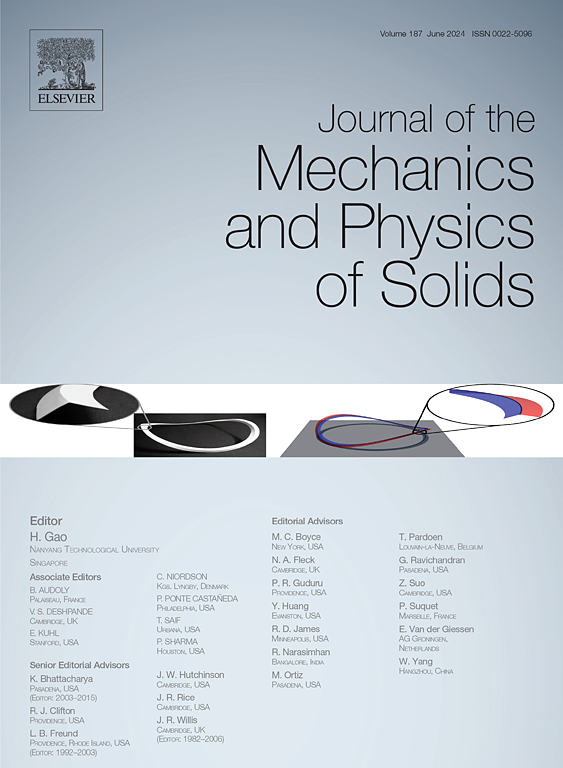粗糙表面黏着接触力学的一种新的基于能量的数值方法
IF 6
2区 工程技术
Q2 MATERIALS SCIENCE, MULTIDISCIPLINARY
引用次数: 0
摘要
在本文中,我们提出了一种创新的边界元方法来处理三维弹性粘接力学。至关重要的是,数值过程是完全通用的,因为它可以研究光滑和粗糙的接触,它基于一种新的算法来评估三维域中的接触面积:接触块的轮廓是通过施加系统的总能量是静止的来确定的。该方法成功地验证了众所周知的JKR解决方案,涉及到与半空间接触的光滑球体。然后,为了评估求解器的鲁棒性,研究了双正弦波表面与弹性半空间之间的多凹凸面接触:具体而言,当关注两个凹凸面时,相关接触块的合并被证明是准确描述的。最后,将分析扩展到粗糙表面之间的接触问题:该解决方案与文献中可用的其他数值方法进行了成功的基准测试,表明我们的数值方法具有很高的精度和可靠性,从而代表了一种新的有效方法来处理具有一定界面能的所有接触问题。本文章由计算机程序翻译,如有差异,请以英文原文为准。
A novel energy-based numerical approach for adhesive contact mechanics of rough surfaces
In this paper, we present an innovative Boundary Element methodology to deal with 3D elastic adhesive contacts. Crucially, the numerical procedure, which is fully general as it enables the study of both smooth and rough contacts, is based on a novel algorithm to assess the contact area in a three-dimensional domain: the contours of the contact patches are determined by imposing that the total energy of the system is stationary. This methodology is successfully validated against the well-known JKR solution involving a smooth sphere in contact with a half-space. Then, to evaluate the robustness of the solver, the multi-asperity contact between a double sine wave surface and an elastic halfspace is studied: specifically, when focusing on two asperities, the coalescence of the related contact patches is shown to be accurately described. Finally, the analysis has been broadened to the contact between rough surfaces: the solution, successfully benchmarked with other numerical methods available in literature, demonstrates that our numerical approach is highly accurate and reliable, thus representing a new efficient methodology to deal with all contact problems characterized by a certain interfacial energy.
求助全文
通过发布文献求助,成功后即可免费获取论文全文。
去求助
来源期刊
CiteScore
9.80
自引率
9.40%
发文量
276
审稿时长
52 days
期刊介绍:
The aim of Journal of The Mechanics and Physics of Solids is to publish research of the highest quality and of lasting significance on the mechanics of solids. The scope is broad, from fundamental concepts in mechanics to the analysis of novel phenomena and applications. Solids are interpreted broadly to include both hard and soft materials as well as natural and synthetic structures. The approach can be theoretical, experimental or computational.This research activity sits within engineering science and the allied areas of applied mathematics, materials science, bio-mechanics, applied physics, and geophysics.
The Journal was founded in 1952 by Rodney Hill, who was its Editor-in-Chief until 1968. The topics of interest to the Journal evolve with developments in the subject but its basic ethos remains the same: to publish research of the highest quality relating to the mechanics of solids. Thus, emphasis is placed on the development of fundamental concepts of mechanics and novel applications of these concepts based on theoretical, experimental or computational approaches, drawing upon the various branches of engineering science and the allied areas within applied mathematics, materials science, structural engineering, applied physics, and geophysics.
The main purpose of the Journal is to foster scientific understanding of the processes of deformation and mechanical failure of all solid materials, both technological and natural, and the connections between these processes and their underlying physical mechanisms. In this sense, the content of the Journal should reflect the current state of the discipline in analysis, experimental observation, and numerical simulation. In the interest of achieving this goal, authors are encouraged to consider the significance of their contributions for the field of mechanics and the implications of their results, in addition to describing the details of their work.

 求助内容:
求助内容: 应助结果提醒方式:
应助结果提醒方式:


